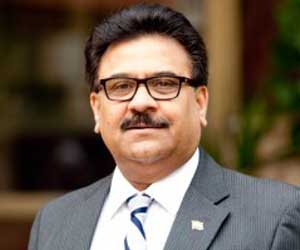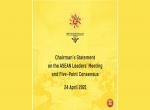When Prime Minister Narendra Modi took over the reins of India in 2014, there were some concerns within the Arab and the Muslim world that India’s foreign policy will tilt towards Israel at the expense of the Palestinian cause and historic relations between India and West Asia. However, that was not to be. The Indian government fully understood West Asia’s significance in India’s overall security dynamics and the country’s relation with the region, which it considers to be its extended neighbourhood, is driven by bilateral approaches that focus primarily on the 3Es matrix i.e. energy security, economic engagement, and expatriate welfare.
West Asia accounted for over 60% of India’s crude oil imports. And 80% of India’s external trade (50% exports and 30% imports) passes through key waterways in the region such as the Red Sea. Besides, the Gulf Cooperation Council (GCC) is India’s largest regional-bloc trading partner and in FY 2022-2023, the grouping accounted for 15.8% of the country’s total trade. Gulf countries are also important because of their Foreign Direct Investment (FDI) in India, with the UAE being the seventh-largest source. There are also over 9.5 million Indian workers in West Asia, the vast majority of them in GCC countries. Their annual remittances play a crucial role in replenishing India’s foreign exchange reserves and maintaining the value of the Indian rupee. In fact, annual remittances from Indian workers in West Asia accounted for about 16% of India’s total foreign exchange reserves.
Until the advent of Prime Minister Narendra Modi’s government, India-West Asia relations were largely transactional and devoid of any strategic component. The lack of engagement between India and West Asia is evident in the paucity of high-level visits. For example, between the then Prime Minister Indira Gandhi’s visit to the region in the 1980s and 2008, there have been no high-level visits from India to West Asia. But under Prime Minister Narendra Modi, the frequency of high-level visits from India to the region have increased drastically. That has catapulted India-West Asia relations from one that was transactional to one that is now truly strategic.
De-hyphenation
Crucially, Prime Minister Narendra Modi’s government has de-hyphenated India’s interactions with countries in West Asia. Relationships between India and countries in the region are now being built on a bilateral basis. At the same time, India has maintained a principled approach on major issues such as the Israel-Palestine conflict and intra-regional rivalries and competition. Before this, relations between India and countries in West Asia were often held hostage to the sensitivities of the other party, and not necessarily to India’s own interests. Optics had become more important than the content. That was particularly true of the Israel-Palestine conflict. Whenever any Indian leader’s visit was planned, it had to be to Palestine and Israel or vice versa. However, under Prime Minister Narendra Modi, the two countries are engaged with separately. And even as India expressed its support for the establishment of a viable and sovereign Palestinian state through direct dialogue and diplomacy, it also built closer ties with Israel. That engagement culminated in Prime Minister Narendra Modi visiting Israel and Palestine in 2017 and 2018 respectively. In doing so, he became the first Indian Prime Minister to visit both countries. His visits to Israel and Palestine are standalone visits that focussed productively on bilateral and regional issues. As a result, India has emerged as a trusted partner for both countries. The Palestinians have even conferred their highest civilian honour the “Grand Collar of the State of Palestine” on Prime Minister Narendra Modi during his visit to the country. Other countries in West Asia have also appreciated India’s efforts and therefore have honoured Prime Minister Narendra Modi with their highest awards. That included the “King Abdulaziz Sash” by Saudi Arabia, the “Order of Zayed” by the UAE, and the “King Hamad Order of the Renaissance” by Bahrain. Prime Minister Narendra Modi was perhaps the most decorated foreign leader in West Asia.
Bridging the Visit Deficit
Likewise Prime Minister Narendra Modi’s visits to the UAE, Saudi Arabia, Qatar, Oman, Egypt, Jordan, Bahrain, and Iran have transformed what were once routine and transactional partnerships into strategically-oriented relationships. The focus of cooperation is wide-ranging and it includes food, fertilizer, energy, defence, counterterrorism, intelligence exchange, climate change, renewable energy, artificial intelligence, cyber security, space and civil nuclear cooperation, people to people contact, etc. Maritime cooperation and strategic investments have become a top priority. Given India’s growing economic profile, GCC countries have looked to India as an attractive place to invest. Not only did the UAE invest in India’s strategic oil reserves for the first time, it also allowed major Indian oil companies to secure stakes in their oil fields and oil exploration activities. While the Saudi Crown Prince Mohammed bin Salman announced a pipeline for investments to the tune of USD 100 billion, the UAE’s Sheikh Mohammed bin Zayed has confirmed a USD 75 billion funds for investments in India. All the while, leaders from West Asia have paid several visits to India. And India had even extended invitations to non-member countries like the UAE, Oman, and Egypt to attend the G20 summit in New Delhi in 2023.
The UAE - A Unique Partner
The UAE has emerged as the lynchpin of India’s Act West-Act Fast policy and its expanding engagement with the Gulf region. In particular, it plays an indispensable role in India’s move towards a more regional and sub-regional approach even as it continues working assiduously in the bilateral matrix. That include groupings such as India, Israel, UAE, USA (I2U2) and India, UAE, Saudi Arabia and USA (IUSU) where key projects are moving apace in the food and energy security domains. The UAE remains a major investor in India and it is also the country’s third largest trading partner. It was also the first country with which India signed the Comprehensive Economic Cooperation Agreement (CEPA) in 2022. This agreement is a trendsetter because of the short time of 88 days in which it was negotiated and concluded and it has already begun to show positive results. A Bilateral Investment Treaty was also signed during Prime Minister Narendra Modi's recent visit to the UAE. That would take the India-UAE relationship to the next level. In the energy domain, the UAE became the first country to invest in India’s strategic crude oil reserves. It also allowed Indian oil company ONGC Videsh Ltd. to hold stakes in their oil blocks. Beyond this, India and the UAE have also strengthened their cooperation in space, nuclear, cyber security, AI, healthcare, maritime domain, and defence and security continues apace. Both sides also collaborated closely on climate change, countering terrorism and extremism, and intelligence sharing, and they have begun to pay credible dividends.
Decimating the Pakistan Factor
The UAE also appreciated India’s position on Pulwama and Balakot as well as on the revocation of Article 370. That was indicative of the “decimation of the Pakistan factor” that had earlier dictated India-UAE relations during its transactional phase. Most countries now consider these as India’s internal matters. The UAE’s extension of an invitation to the late Foreign Minister Sushma Swaraj to address the Foreign Ministers’ meeting of the Organisation of Islamic Cooperation (OIC) in Dubai in 2019 was indeed a remarkable message to their Islamic comity of nations including Pakistan. Again, as far as diaspora is concerned, the UAE has increased the intake of Indians in their developmental journey with estimated numbers reaching over 3.5 million, the highest in the region. If these are not potent indicators of a strategic partnership in full display, then what more would there be. No wonder Prime Minister Narendra Modi termed his visit to the UAE as a home coming to his brother Sheikh Zayed.
Beyond Bilateralism
Over the last few years, India’s outreach to West Asia has evolved from bilateral engagements to sub-regional and regional engagements with new mechanisms coming into play. A case in point is the India Middle East Europe Economic Corridor (IMEC), a potentially game-changing connectivity initiative that was launched by India, Saudi Arabia, the UAE and several Western countries in 2023. The IMEC will comprise two separate corridors, the eastern corridor connecting India to the Gulf and the northern corridor connecting the Gulf to Europe. The corridor will provide reliable and cost-effective cross-border ship to rail transit networks to supplement existing maritime routes. It intends to increase efficiency, reduce costs, secure regional supply chains, increase trade accessibility, enhance economic cooperation, generate jobs and lower greenhouse gas emission, resulting in a transformative integration of Asia, Europe and West Asia. Although the initiative has remained dormant due to the ongoing Israel-Hamas war, participating countries remain committed to it. For example, during his most recent and sixth visit to the UAE, Prime Minister Narendra Modi and leaders of the UAE signed a framework agreement to enable smooth progress of IMEC. Likewise, greater collaboration on the India-GCC track is being envisaged which should open up more opportunities for Indian businesses which are as such heavily invested in the region.
Way Ahead
Given the depth of engagements, quality of outcomes, and appreciation of Indian sensitivities and opportunities, the current government’s West Asia policy perhaps has been the most productive. However, it will be useful to examine the following aspects a bit more dispassionately to devise and craft the requisite strategies in times to come since the region, like the disrupted global order, is in a flux and diversification is the currency of conversation.
- While the Pakistan factor has been neutralised in West Asia, Chinese economic and strategic heft has expanded through its Belt and Road Initiative (BRI) across the region. As regional players undertook their own Act East policies and as they hope for some modus vivendi between India and China so that they do not have to choose sides, India is presented with new challenges. The country therefore, ought to strategize carefully as its Indo-Pacific strategy in the Western Indian Ocean region could be impacted adversely. The Gulf and the larger West Asia region will continue to figure prominently in India’s foreign and security policy matrix as the global churn and big power competition in the region continues including the escalatory impact of the Israel-Hamas war and Israel-Iran war.
- Regional countries trust India’s benign and sane foreign policy approaches that are underpinned by strategic autonomy and they expect it to play a larger regional and global role as befitting of a major power. As such, it may be desirable to initiate concrete actions and be a facilitator to reduce conflicts and enable dialogue rather than only propagating it. It is often helpful to depute Special Envoys to assess the situation and provide comfort that New Delhi is ready to play a role. Success is not guaranteed given the complexities of issues but effort to help de-escalate it in itself is a reward. Sometimes we need to be prepared for certain costs that a power has to incur.
- Focussed efforts should be made to create stakeholdership through mutual investments in critical sectors and areas of economy and enterprise.
- Soft and smart power needs to be deployed more efficiently to leverage the existing civilizational ties in the region. It will sync well as many regional powers are looking to adopt more humane, tolerant and secular policies with extensive socio-economic reforms. Recent allocation of land and inauguration of a Hindu temple in Abu Dhabi is an example.
- Greater collaboration within the context of BRICS and SCO with countries from the region could be explored.
- Defence and security and intelligence cooperation to deal with growing threats from non-traditional actors will require a robust and well-rounded strategy.
- India has robust Islamic credentials and this could be easily leveraged to blunt the viciousness of countries like Pakistan in the OIC. However, it would be an imperative to ourselves to remain vigilant about the religious sensitivities of others.
- We may also have to remain mindful of the potential emergence of a new strategic dynamic like China, Russia, Iran, Pakistan, Turkey, Afghanistan, and Qatar or CRIPTAQ in West Asia which may have repercussions for India’s regional outreach.
(The paper is the author’s individual scholastic articulation. The author certifies that the article/paper is original in content, unpublished and it has no been submitted for publication/web upload elsewhere, and that the facts and figures quoted are duly referenced, as needed, and are believed to be correct). (The paper does not necessarily represent the organisational stance... More >>
Image Source: https://twitter.com/HSajwanization/status/1757422770038731004/photo/4











Post new comment